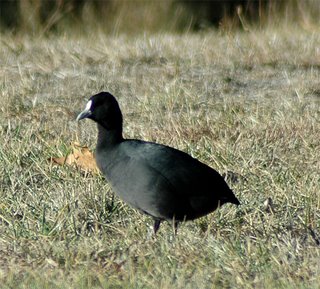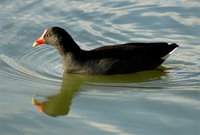 Yesterday I posted about Purple Swamp Hens (Galinules). I commented that the associated bird, the Eurasian Coot was "totally aquatic". Ooops. Today I went to Lake Tuggeranong, to be confronted by a bunch of Coots out grazing. Admittedly, as soon as they saw me, they headed to the water, where, clearly they felt more comfortable. However, I feel obliged to set the record straight. They also graze on dry grass, near water, as in this photo.
Yesterday I posted about Purple Swamp Hens (Galinules). I commented that the associated bird, the Eurasian Coot was "totally aquatic". Ooops. Today I went to Lake Tuggeranong, to be confronted by a bunch of Coots out grazing. Admittedly, as soon as they saw me, they headed to the water, where, clearly they felt more comfortable. However, I feel obliged to set the record straight. They also graze on dry grass, near water, as in this photo.
In the main cities of South-eastern Australia, there are 3 basically similar birds which are common wherever lakes and parks are found. (I am excluding Ducks, etc.) These are either aquatic birds which gather near picnic grounds, or birds with longish legs which hang around on the grass, looking for scraps from picnickers. Simply put, these birds are most likely to be Swamp Hens, Moor Hens, and Coots. Today I will deal mostly with the Moor Hen (and the others just in comparison). There are other, more exotic birds, called Black-tailed Native Hens, and in Tasmania, another species. But these three species are the most commonly seen, between Brisbane and Melbourne. Other related birds are Crakes and Rails, but they are usually very shy, and seldom seen. None of these birds under discussion is shy - far from it.
 The Dusky Moorhen is the third bird in this group, which people often get confused about. This bird has a red beak, with a yellow tip, (as an adult). In general, its beak is like the Swamp Hen's, (but much finer). This bird is quite at home in the water (like a Coot). In size, it is slightly larger than the Coot, and only about half the size of the Swamp Hen. So, the main differences between them are (a) size (Swamp Hen clearly the largest); (b) preference for water over land 1 - Coot, 2 - Moor Hen, and coming a bad last - Swamp Hen.
The Dusky Moorhen is the third bird in this group, which people often get confused about. This bird has a red beak, with a yellow tip, (as an adult). In general, its beak is like the Swamp Hen's, (but much finer). This bird is quite at home in the water (like a Coot). In size, it is slightly larger than the Coot, and only about half the size of the Swamp Hen. So, the main differences between them are (a) size (Swamp Hen clearly the largest); (b) preference for water over land 1 - Coot, 2 - Moor Hen, and coming a bad last - Swamp Hen.
 So, of these 3 birds, if it is swimming freely and cheerfully, it is a Coot or a Moor Hen. (Check photo at left). If so, look for a red beak and head shield (Moor Hen), or silvery white, (Coot). Clearly, the bird on the left is a Coot, the other a Moor Hen.
So, of these 3 birds, if it is swimming freely and cheerfully, it is a Coot or a Moor Hen. (Check photo at left). If so, look for a red beak and head shield (Moor Hen), or silvery white, (Coot). Clearly, the bird on the left is a Coot, the other a Moor Hen.
If it is walking about amongst the reeds, it is likely to be, in order, 1 - Swamp Hen, 2 Moor Hen (distinguish them by size) 3 Coot (they do nest in reeds - look for the silver colour of the beak and head shield).
There is another more subtle clue - the shape of the tail and wings. Coots look as if they have rounded backs and their tails are not prominent. They fade off into the water. That "rounded back" look is apparent, even in the photo of the bird on land. The Moor Hen has a prominent, upward-tilted tail and its wings follow that line. So, its tail comes to a point, held high above the water. That is always helpful, in case you find an immature Moor Hen, which has a dark olive green beak, with maybe a touch of red just showing. Look at the wings and tail. It is immediately distinctive between these two species which swim freely. If its tail is pointed diagonally up, at about 30 degrees. and it shows a flash of white underneath, it is a Dusky Moorhen.
 Finally, the Swamp Hen is a very active bird, on land. When it runs (as it does very well) it typically flicks its tail, showing a bold "alarm signal" patch of white feathers under its tail. This is totally distinctive. So even if you just get a poor, rear view of a large swamp bird, but it was flicking its tail, then you know it was a Swamp Hen. This particular bird ran away from me (sorry the photo is blurry), but it took with it a juicy piece of grass to chew on, when it was safely distant from me.
Finally, the Swamp Hen is a very active bird, on land. When it runs (as it does very well) it typically flicks its tail, showing a bold "alarm signal" patch of white feathers under its tail. This is totally distinctive. So even if you just get a poor, rear view of a large swamp bird, but it was flicking its tail, then you know it was a Swamp Hen. This particular bird ran away from me (sorry the photo is blurry), but it took with it a juicy piece of grass to chew on, when it was safely distant from me.

No comments:
Post a Comment